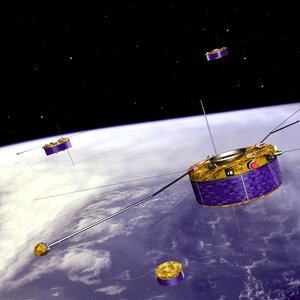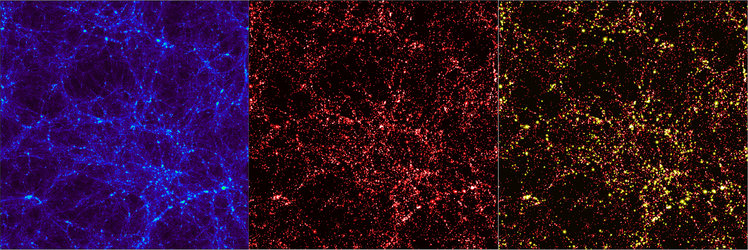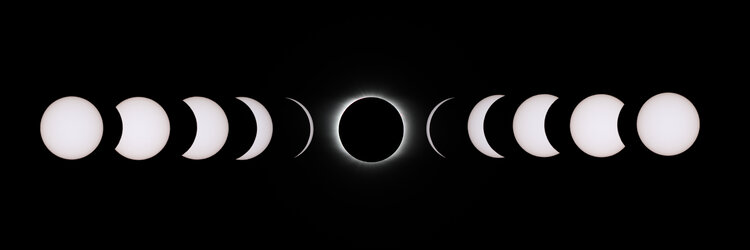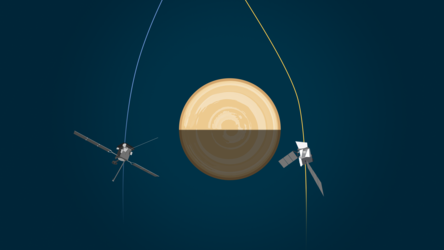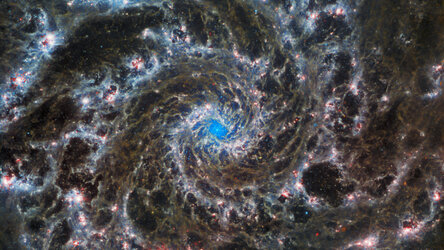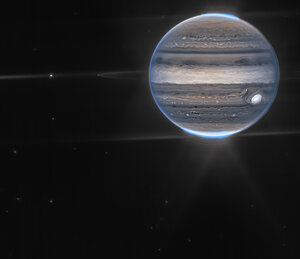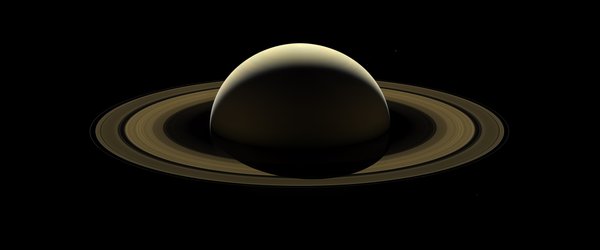N - O
N
Near-Earth asteroid
Rocky object which passes close to the Earth. Most, if not all, seem to have originated in the main asteroid belt. Their Earth-approaching orbits are the result of collisions with other asteroids or the gravitational influence of Jupiter. Many thousands of asteroids inhabit the inner Solar System. The main groups are the Amors, which travel between the Earth and Mars; the Apollos, which cross Earth's orbit; and the Atens, which stay mainly inside Earth's orbit. Occasionally, one of these objects will collide with the Earth, creating a large impact crater and possibly causing mass extinction of life forms.
Nebula
Cloud of dust and gas in space.
Neptune
At more than 30 AU from the Sun, Neptune is the eighth planet away from our star. It is one of the gas giants and has a dense atmosphere consisting mainly of hydrogen. Average surface temperature is 58 K.
Neutrino
A fundamental particle which has no electric charge and hardly interacts with matter. Thus it is very elusive and difficult to detect. Neutrinos only have a small mass but they are very numerous and may account for some of the dark matter in the Universe. The existence of the neutrino was postulated by Enrico Fermi to explain a loss of energy in the radioactive beta decay. The neutrinos produced in the beta decay carry away the lost energy.
Neutron
Particle in atomic nuclei. A neutron has no charge but a little more mass than the other constituent of atomic nuclei, the proton. Neutrons are made up of three quarks. If neutrons are not bound in an atomic nucleus they decay into a proton, an electron and an antineutrino.
Neutron star
An extremely dense star comprised mainly of neutrons, endpoint of the life of a massive star which has exploded as a supernova. Under huge gravitational forces electrons have been compressed into protons and produced neutrons. A typical neutron star has about 3 times the mass of the Sun but a radius of only 10 kilometres. Fast spinning neutron stars can be observed as pulsars. If the Sun were to become a neutron star it would have a diameter of only 20 km.
Nitrogen
A chemical element, symbol N, with atomic number 14; under normal conditions it is a diatomic gas (N2). One of the main constituents of proteins and a major constituent of Earth's atmosphere.
Non-baryonic matter
Matter that is not made of baryons (i.e. of neutrons and protons), and is thus different from the matter which makes up the planets, human beings... everything you can see around you. It has been proposed that part of the dark matter in the Universe is non-baryonic matter. It is classified as 'cold' non-baryonic matter or 'hot' non-baryonic matter. Cold non-baryonic matter would be made of particles moving much slower than light (there are several non-detected candidates); hot non-baryonic matter is made of particles moving very fast, such as neutrinos. Non-baryonic matter (hot or cold) is supposed to interact weakly with radiation. Therefore, the 'imprints' left by the non-baryonic matter in the cosmic background radiation would be different than those left by the baryonic matter. This attribute could be used to measure the contribution of non-baryonic matter to the total amount of mass in the Universe.
Nova
A star which suddenly increases in brightness by a factor of more than hundred. Novae are close binary stars of which one component is a white dwarf star. Material from the companion star is transferred onto the white dwarf and triggers explosive nuclear reactions, resulting in the increased brightness.
Nuclear fusion
A nuclear reaction in which two small atomic nuclei fuse to form a larger one. The process releases large amounts of energy because the mass of the product is less than the mass of the fusing particles. The mass deficit corresponds to an energy release (according to Einstein's famous E=mc2 equation). Stars generate their energy by nuclear fusion. In the Sun hydrogen fuses to helium with the release of energy.
Nucleosynthesis
The chemical reaction by which atomic nuclei (of any chemical element) are created. Nucleosynthesis took place when the Universe was very young. Today it takes place, for instance, in the stars' cores: the hydrogen, the most abundant component of a star, is converted into helium (this is referred to as helium nucleosynthesis) a process by which a huge amount of energy is released. This is the energy that allows the star to keep shining. When the hydrogen is used up then the star begins to transform the helium into other elements, and so on. The elements are hence used as fuel for the star, and the kind of element used in each stage of the star's life is an indication of how long it has been shining. Therefore, the chemical components of a star can provide a lot of information about its history. See also Primordial nucleosynthesis.
Nucleus
(1) The solid, icy object at the heart of a comet.
(2) The positively charged central portion of an atom, which makes up most of the atom's mass.
O
Occultation
Complete or partial eclipsing of one astronomical object by another.
Oort cloud
Swarm of billions of comets thought to surround the Solar System between 2000 and 20 000 AU from the Sun. First proposed by E. Öpik in 1932 and later developed by J. Oort in the 1950s. Its existence is based on studies of long-period comet orbits, which seem to have their aphelia in this zone.
Open Universe
See Critical density.
Opposition
The point at which a planet that is further away from the Sun than the Earth, lines up with the Sun and Earth. Opposition is a good time for observation because the planet is near its closest point to Earth.
Optical light ('visible' light)
The light that can be detected by the human eye. It has a wavelength between 4000 and 7000 angstroms (or between 0.00004 and 0.00007 cm). See also Electromagnetic radiation.
Optics
Elements (glasses, mirror, telescope...) used to see or visualise something.
Orbit
The path through space of one celestial body or spacecraft about another.
Orbit acquisition
Reception of the telemetry containing the information about the orbital parameters of the spacecraft.
Orbiter
A spacecraft orbiting around a planet or other celestial body to act as a telecommunications relay or from which remote sensing observations can be made.
Organics
Carbon-based material.
Orientation
Position in space relative to a reference point.
Ozone, ozone layer
A layer in the Earth's atmosphere at 15-30 km altitude in which ozone is at higher concentration than at lower or higher altitudes. The ozone is created by a series of processes beginning with the splitting up of the oxygen molecule to single oxygen atoms. The ozone layer protects the Earth from UV radiation harmful to life.















 Germany
Germany
 Austria
Austria
 Belgium
Belgium
 Denmark
Denmark
 Spain
Spain
 Estonia
Estonia
 Finland
Finland
 France
France
 Greece
Greece
 Hungary
Hungary
 Ireland
Ireland
 Italy
Italy
 Luxembourg
Luxembourg
 Norway
Norway
 The Netherlands
The Netherlands
 Poland
Poland
 Portugal
Portugal
 Czechia
Czechia
 Romania
Romania
 United Kingdom
United Kingdom
 Slovenia
Slovenia
 Sweden
Sweden
 Switzerland
Switzerland





























